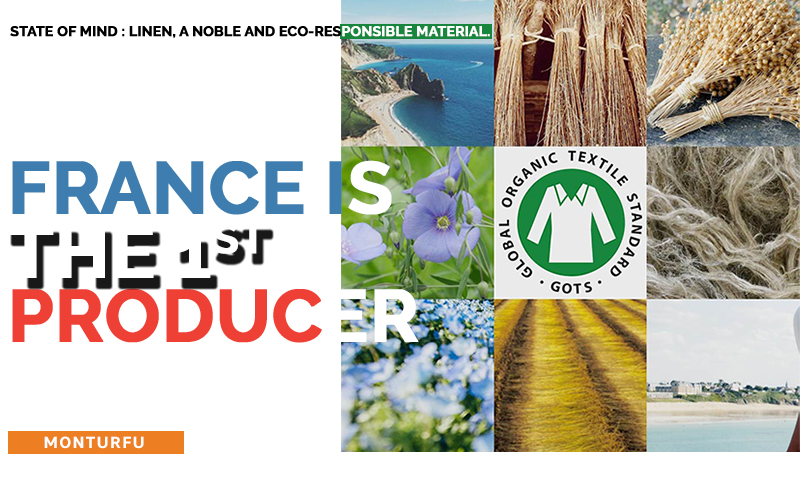LINEN IS A NOBLE MATERIAL. STATE OF MIND
FRANCE IS
THE 1ST
PRODUCER.
We are the leading producers of flax in the world. France represents 80% of the world’s flax production. One hectare of flax retains 3.7 tonnes of carbon dioxide each year.
In fact, flax is a real carbon sink. Each year in France, its cultivation allows to easily absorb 250 000 tons of CO2. It is one of the only plant textile fibers originating from the European continent. Moreover, its culture is not relocatable.
Linen is a noble material and eco-responsible : truly ecological.
It is a fundamentally ecological material. From the flower to the flax thread. Flax is generally cultivated in temperate areas near the sea, such as northern France and Belgium. Its natural vegetable fiber is used in textiles as well as in industry.
Linen is an ecological natural fiber.
The cultivation of flax requires little water and pesticides. The plant grows naturally thanks to the heat of the sun and rainwater, so it does not require any irrigation, unlike cotton for example.
In addition, the manufacturing stages of linen, the scutching, the spinning, the weaving and the making, consume little energy.
What exactly are we talking about?
Liniculture, for those who know it well, is mainly located in the north of France, in Brittany and Normandy. Its excellence is the result of a beautiful meeting at the right place, at the right time between :
-
favorable climatic conditions,
-
generous soils
-
and the know-how of flax growers.
Which climate for the flax ?
Flax is a local herbaceous plant that grows in a temperate and humid climate. It is grown in Western Europe along a wide coastal strip stretching from southern Normandy through Belgium to the Netherlands.
At maturity it gives blue, purple or white flowers.
Today, 2/3 of the world production of dyed flax comes from Europe. In France, flax is grown in Seine Maritime, Nord, Pas de Calais, Somme, Oise, Eure and Calvados. France is known for its high quality linen with fine and resistant fibers.
Linen is a noble and eco-responsible material : characteristics.
This natural fiber is totally biodegradable. It is then important to note that flax is considered as an ecological material, even if it is not organic.
First of all, flax cultivation requires very little irrigation. In fact, rainwater is more than enough. in this case, it must be said that the cultivation of flax has a very interesting environmental impact compared to the cultivation of cotton. It is a true and naturally ecological material. In short, the production of linen is super green. Each step of the processing is done mechanically and without chemical solvents. One hectare of flax corresponds to an average of 1,300 kilos of dyed long fibers.
It is the noble material that we love to wear.
Strong, light and flexible at the same time, linen fiber has a very long life. All linen lovers admire its incredible resistance to tension. 2 to 3 times higher than cotton.
Although the linen fiber is very rigid at first sight, it softens with time. And thus loses the pectins which are essential to its rigidity.
Indeed, pectins structure and hold the different fibers together. This is also what makes linen hydrophilic, we mean very absorbent, but also anti-static. Flax can retain 20% of its weight in moisture !
Linen is a noble and eco-responsible material: linen clothes.
Linen is a thermoregulating, hypoallergenic and antibacterial material. It retains heat as well as coolness.
Therefore, linen blouses and other garments are particularly pleasant to wear in hot or cold weather. Lightweight, they keep your body at an ideal temperature while being super absorbent. Goodbye to heavy sweating. It is also a very good insulator, thanks to its hollow fiber.
What is linen in fact ?
Flax is a herbaceous, bastard plant. This means that its natural fibers are found in its stem. So they are not lodged in its beautiful blue flowers. Herbaceous, simply means that it has the appearance of grass.
Flax is a plant that is particularly fond of temperate western climates. This is why France is the ideal place to grow it.
Linen is a noble and eco-friendly material.
It is the oldest natural material in the world. At the time of the pyramids, the bodies of the Pharaohs were embalmed in strips of linen. These populations were already aware of the qualities of this fiber. Today, it is still cultivated for its textile fibers and its oil seeds.
It is also a very resistant vegetable fiber! One could even say intelligent since it knows perfectly how to use wisely the resources of its soil. Therefore, it needs almost no fertilizer or even pesticides.
The cultivation of flax.
Flax seeds are sown in spring. This plant needs 120 to 150 days to emerge and offer its first flowers.
Flax is a natural material that needs neither pesticides nor a lot of water to grow. 700 mm of water well distributed over the whole vegetative cycle is enough. But its 100% natural culture is delicate: the plant must not receive either too much water or too much sun and thus depends strongly on the weather conditions.
The treatment of flax with natural fertilizers and insecticides.
This avoids the use of toxic products for the environment, the farmers, and the final consumers. At the time of flowering, the flax fibers reach their maximum size. The longer they are, the more resistant they are. The flax is then pulled up and not mowed. This avoids damaging the plant. Then the flax fibers are laid on the ground in a swath, that’s to say symmetrically. Seen from above, a flax field has a real graphic beauty.
Linen is a noble and eco-friendly material.
It is then that one extends it on the ground, the flax will rest and will be transformed naturally thanks to the method of retting on the ground. This method allows to extract naturally the fibers of the stem by the alternations of rains and suns from July to September.
The manufacture of linen fiber.
During harvest, the stems are harvested directly from the root. They are not mowed. They are placed in hedges so that they can dry. And at the same time they are stripped of their seeds. Then comes the stage of retting and turning, directly on the fields with rain, dew and sun.
Linen is a noble and eco responsible material.
Afterwards, the bales are dyed and combed. And we beat the straws to remove the woody part that we constitute in shives. Finally we separate the tow, the short fibers from the long fibers. We obtain noble fine threads. From then on, the yarns are combed with a finer and finer comb in order to separate the fibers correctly. At the end of this process, we remove the angel hair, very fine fibers, almost silky. The fibers are then stretched to form ribbons. And with the twisting process they are bound together. The spinning machine is ready, the fibers can be woven, knitted and made up.
100% edible.
In addition, it is a zero waste plant. All the parts are not only useful, but used. Either we recover the flax seeds to prepare the next seeds, or to make food oils rich in linolenic acid, omega 3. Linseed oil can also be used for paints.
On the other hand, fine fibers are used for clothing, linen and upholstery. As for the thicker flax fibers, they are used as insulating material or introduced in composite materials.
What are the uses of linen in industry ?
Flax is known as a strong and light fiber. Today, industry uses it to absorb vibrations, to insulate and to reinforce its composite materials. Flax is used in the automotive sector, in the manufacture of components and insulators. It is also used in the hi-tech sector, in the manufacture of headphones or in the sports industry, in the manufacture of skis, bicycles, tennis rackets, surfboards, etc. Also, linen is flexible and resistant. It is naturally used in the manufacture of banknotes and cigarette papers.
The linen in the textile in ecological mode.
On the other hand, the textile industry uses linen to make all kinds of products and clothing: linen bags, linen pants, linen shirts, shoes, household linen. Very ecological naturally, linen is a very appreciated material in the responsible fashion.
A noble, light and resistant textile.
In order to promote the short circuit and European know-how, the Masters of Linen label certifies 100% European linen without irrigation and without GMOs. Other labels also work in the same dynamic, for example the GOTS Global Organic Textile Standard label, or the Oeko-Tex label etc.
Linen is a noble and eco-friendly material.
Even if its use is far from that of cotton in the textile industry, linen has the wind in its sails. It is used and used more and more in the manufacture of canvas shoes, ribbons, fabrics, pants, shirts or even bags. We quickly characterize linen as a noble and high-end material. Of course with linen, we make very beautiful fabrics.
The results of an ecological and natural plant par excellence.
Linen is recyclable and biodegradable. It legitimately appears to be an excellent choice for the environment and the health of consumers. Thanks to certification labels, then the consumers can find out about the origin and treatment of their fiber and thus better orient their choices for ethical and responsible fashion.
Ok de-MEDEIROS
SOURCES : https://www.atelier-unes.com/blogs/nos-matieres/le-lin-une-matiere-eco-responsable-sous-estimee, https://www.wedressfair.fr/matieres/lin, https://www.wedressfair.fr/matieres/lin-biologique, https://www.merceriecarefil.com/fr/content/56-le-label-oeko-tex, https://www.ecocert.com/fr-FR/certification/textile-biologique-gots, http://linfrance.com/le-club-master-of-linen/






Laisser un commentaire